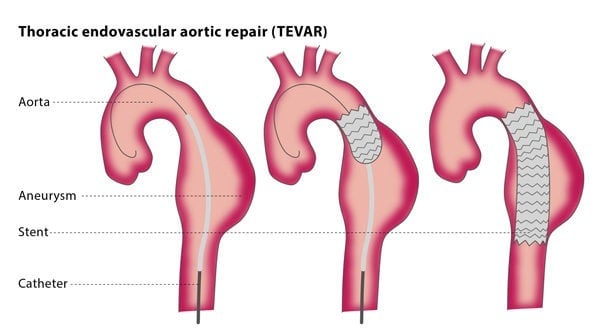Thoracic endovascular aortic repair (TEVAR)
What is thoracic endovascular aortic repair (TEVAR)?
The aorta is the largest vessel in your body and carries the blood away from your heart to the rest of your organs. A thoracic aneurysm occurs if the arterial wall weakens and develops a bulge, meaning blood is flowing into the weakened area. This bulge is in the artery situated within the rib cage.
The TEVAR procedure involves the placement of a covered stent (a metal mesh tube with a layer of fabric) into the weakened area of the artery. This provides a route for the blood to flow without pooling in the bulge.
How does the procedure work?
The procedure will be carried out using image guidance, such as ultrasound, CT or MRI, to control the insertion of the devices and the energy deposition. You will bewill be anaesthetised for the procedure. For most ablation procedures, the interventional radiologist will insert one or more needles or applicators into your tumour to destroy the tumour while preserving the surrounding healthy tissue.

There are also non-thermal techniques that use different types of electric current, electric plasma (Coblation) or chemical agents. Irreversible electroporation uses high voltage electric shocks to pierce the cell membranes and cause cell death. Electrochemotherapy uses the same approach to open the cell membrane for chemotherapeutic agents.
Each of these techniques has its specific advantages and disadvantages and there is no technique that suites all types of treatments equally well.
Why perform it?
If you have an aneurysm, it should be monitored by your doctor. It is recommended that you undergo treatment for the aneurysm if it has a diameter of over 6 cm or if it has expanded by over 0.5 mm within a six-month period, to prevent the aneurysm from rupturing, causing death. If the aneurysm is causing symptoms such as pain and abnormal bleeding, you may require emergency treatment.

If the thoracic aneurysm was caused by trauma, such as if the patient was in an accident, TEVAR is a way to rapidly cover and protect the injured area, controlling bleeding and preventing death.
Although surgical treatments for thoracic aortic aneurysms are available, surgery has a significantly higher risk of serious complications and death
What are the risks?
The rate of successfully placing the stent and covering the aneurysm or tear is 98-99%. There are lower rates of pain and serious complications than with surgery, but the main risks associated with TEVAR are the stent displacement and blood collecting in the aneurysm again. This means that you will require regular monitoring, so that if any problems do occur, they can be resolved as soon as possible.
Minor complications include the risk of bruising and infection. There are some serious complications associated with the procedure, including death, stroke, tissue death, limb loss and injury to the kidneys. The rate of serious complications is estimated to be less than 15%, and the risk of death during the procedure is less than 1.5%.. There is also the possibility of the thoracic aorta tearing during the procedure, and in rare cases the spinal cord is injured, causing paralysis. Some patients react to the iodine in the dye used for imaging, which can affect the kidneys.
